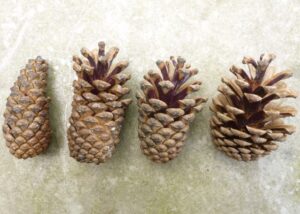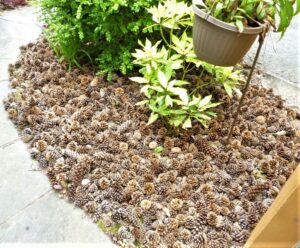Diplodia Tip Blight (Diplodia pinea) is a fungus disease in the landscape commonly observed on Austrian pines (Pinus nigra), but can also be found infecting mugo, red, black, & Scots pines. This blog will emphasize with photos the infections seen on Austrian pines.
The symptoms of Diplodia Tip Blight are stunted or dead shoots. With extensive infections, almost every branch & twig can be affected as the disease spreads over the years. The lower branches of the Austrian pines are usually infected first. For numerous years, the upper canopy will initially show few symptoms. The fungus kills developing needles in the spring, resulting in dead candles that are deformed & much shorter than the growth found on healthy twigs.
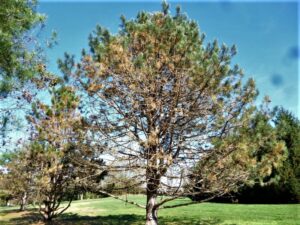
Austrian pine with obvious symptoms from Diplodia Tip Blight infections. (Photo Credit: Steven K. Rettke, Rutgers Coop. Ext.)

Stunted or dead newly emerged twig shoots on Austrian pine branch. (Photo Credit: Steven K. Rettke, Rutgers Coop. Ext.)
Confirming the Diagnosis
Diplodia Tip Blight can potentially have similar symptoms that are caused by infestations from shoot moth twig borers. To confirm a diagnosis on a twig having symptoms, the peeling back of two needles at the bundle sheath can reveal black pustules that contain fungal spores. The fungus infecting the needles is primarily found at the base of a pair of needles under the bundle sheath. If the needles have been dead for enough time, then the fungus could also be found higher up along the needles. Within each individual pustule there could be over a hundred spores. The black pustules can usually be observed with the naked eye but will easily be seen with a 10x hand-lens.
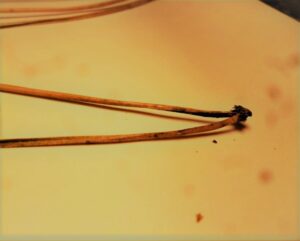
The black pustules of the Diplodia fungus can be found at the base of a pair of needles under the bundle sheath. (Photo Credit: Steven K. Rettke, Rutgers Coop. Ext.)
As the infection occurs, it will cause the tree to exude resin at the infected twig shoots. On stressed trees, resinous sunken cankers may develop on stems & branches resulting in dieback. Basal cankers can also sometimes be observed. Additionally, the staining of sapwood on branches can sometimes be detected when the bark is peeled away.
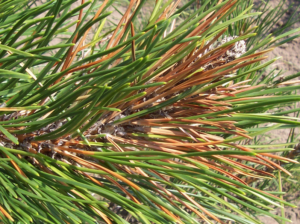
An infected branch twig exuding resin that has dried & turned white. (Photo Credit: Steven K. Rettke, Rutgers Coop. Ext.)
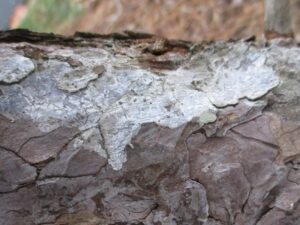
On infected trees, resinous sunken cankers may develop on stems & branches. (Photo Credit: Steven K. Rettke, Rutgers Coop. Ext.)
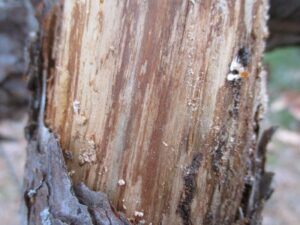
Removal of bark of an infected branch reveals the staining of sapwood. (Photo Credit: Steven K. Rettke, Rutgers Coop. Ext.)
Mature Trees are Susceptible
One of the interesting features to observe with the Diplodia disease is that it rarely causes infections within younger aged pines. Unfortunately, the disease mainly affects the older, larger & more majestic pines in the landscape that may be valued as prized specimens.
Although immature pines may own some genetic juvenile resistance, the key reason older trees are most susceptible to infections is the fact that the primary role of this fungus in nature is to infect & decompose the cones. Therefore, it is not until the trees reach cone-bearing age (~20-25 years for Austrian pines) that the fungus builds-up to reach sufficient levels to effectively infect the trees. As a result, during the spring, massive amounts of spores within the infected cones will rain down from the upper crown. The spores fall onto the lower branches & infect the younger growing tips emerging from twig shoots.
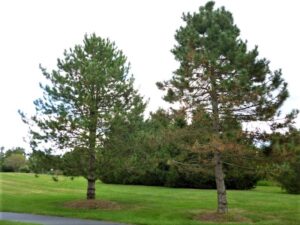
A pair of Austrian pines: The tree on the right shows Diplodia symptoms while the one on the left shows virtually none. The tree on the left produces few cones. (Photo Credit: Steven K. Rettke, Rutgers Coop. Ext.)
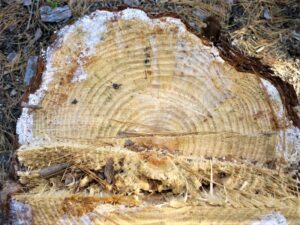
The cut stump of an Austrian pine infected with Diplodia Tip Blight. Difficult to count the rings, but when removed it was 35 years of age. (Photo Credit: Steven K. Rettke, Rutgers Coop. Ext.)
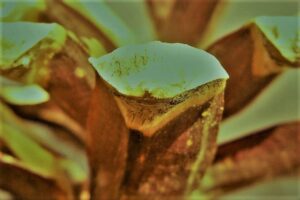
The black pustules containing spores can be observed on the cone scales. (Photo Credit: Steven K. Rettke, Rutgers Coop. Ext.)
The black pustules containing spores can be observed on the cone scales. Again, they are visible with the unaided eye, but will easily be observed with a 10x hand-lens. For significant damage to occur, massive numbers of spores are required. If only relatively few numbers of spores infect a new twig shoot, then symptoms may not be noticeable.
Critical Infection Period
Diplodia Tip Blight is more severe when springtime conditions are cool & wet. However, the fungus only requires a small amount of timely spring rains to cause damaging blight infections. The critical infection period is just when the new buds are first beginning to emerge & break from the sheath. Perhaps up to 90% of the infection occurs during this period. After the tip shoot continues to expand, then the infection rate decreases significantly. If the infection does successfully occur, then it may take a few weeks before twig decline begins to show symptoms. Therefore, after the infection occurs the twig does continue to grow until it becomes completely girdled. Only then does twig growth stop & stunting take place. To improve the appearance of infected pines, prune & remove dead or dying branches during dry weather & attempt to maintain tree vigor.
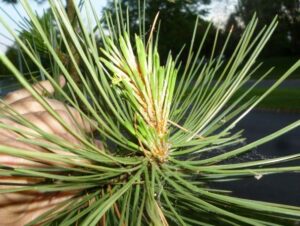
Late spring & this infected twig tip shoot is showing initial symptoms. (Photo Credit: Steven K. Rettke, Rutgers Coop. Ext.)
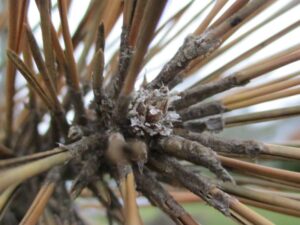
The Diplodia fungus has completely girdled this twig & also killed the terminal bud. (Photo Credit: Steven K. Rettke, Rutgers Coop. Ext.)
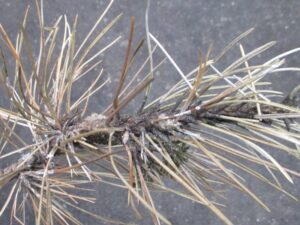
To improve the appearance of infected pines, prune & remove dead or dying branches during dry weather. (Photo Credit: Steven K. Rettke, Rutgers Coop. Ext.)
The disease incidence has shown to vary considerably from year to year. After Diplodia Tip Blight infections begin to show symptoms in the trees, they can continue to live & grow for many years. During some seasons, the trees can show severe symptoms while during others unaffected new twig growth can help the trees appear more aesthetically pleasing.
After infections become increasingly obvious, it may take another 5-10 years before the symptoms necessitate tree removal. Often, a severe stress from drought or infestations by bark beetle borers (or both) will ultimately be the death knell of the tree.

Infestations from pine bark beetles will ultimately kill a stressed tree severely infected with Diplodia Tip Blight. (Photo Credit: Steven K. Rettke, Rutgers Coop. Ext.)
Fungicide Treatments
When management of Diplodia Tip Blight is attempted with fungicide treatments, then it is crucial to have the sprays applied during or shortly before the critical period when the new buds are just beginning to emerge & break from their sheaths. When well-timed fungicides are applied, then this disease can be successfully managed.
A fungicide that has shown to be effective is Cleary 3336 & sprays need to be applied until run-off. When spraying any conifer with fungicides the addition of a spreader-sticker is typically required. A 2nd & possibly a 3rd application is then recommended at 10-14-day intervals. However, if the 1st application is missed during the crucial stage, then any later applications will be far less effective.

Fungicides need to be timed just as the new twig tip growth emerges & breaks the bud sheath. (Photo Credit: Steven K. Rettke, Rutgers Coop. Ext.)
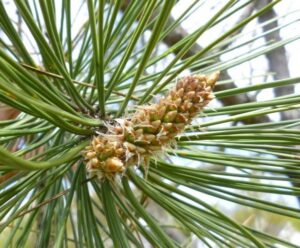
Window missed for best fungicide efficacy treatment against Diplodia Tip Blight. (Photo Credit: Steven K. Rettke, Rutgers Coop. Ext.)
When deciding to manage Diplodia infected pines with fungicides, it needs to be remembered that once a treatment regimen has begun, then continued yearly treatments will be needed. Thorough coverage of new growth with fungicides is essential for optimum control. Landscape clients will truly have to love their Austrian pines for them to accept the expense of protecting these trees year after year.
Working with the Cones
Some arborists have suggested that attempting to remove most of the cones from the pines (especially the upper canopy) as a strategy for controlling Diplodia Tip Blight. Such a tactic is probably impractical since the amount of time & the cost of labor would make it unworkable under virtually any situation. The proper timing of fungicides is a far more realistic approach.
Although the removal of pinecones after they fall from the trees will have little reduced impact on the incidence of disease spread, they can be picked-up & collected from the ground and used as mulch. Austrian pinecones that have grown to nearly full size will continue to have the ability for their cone scales to open & close depending on the moisture conditions. When cones are dry the scales open wide & they make an attractive mulch.
